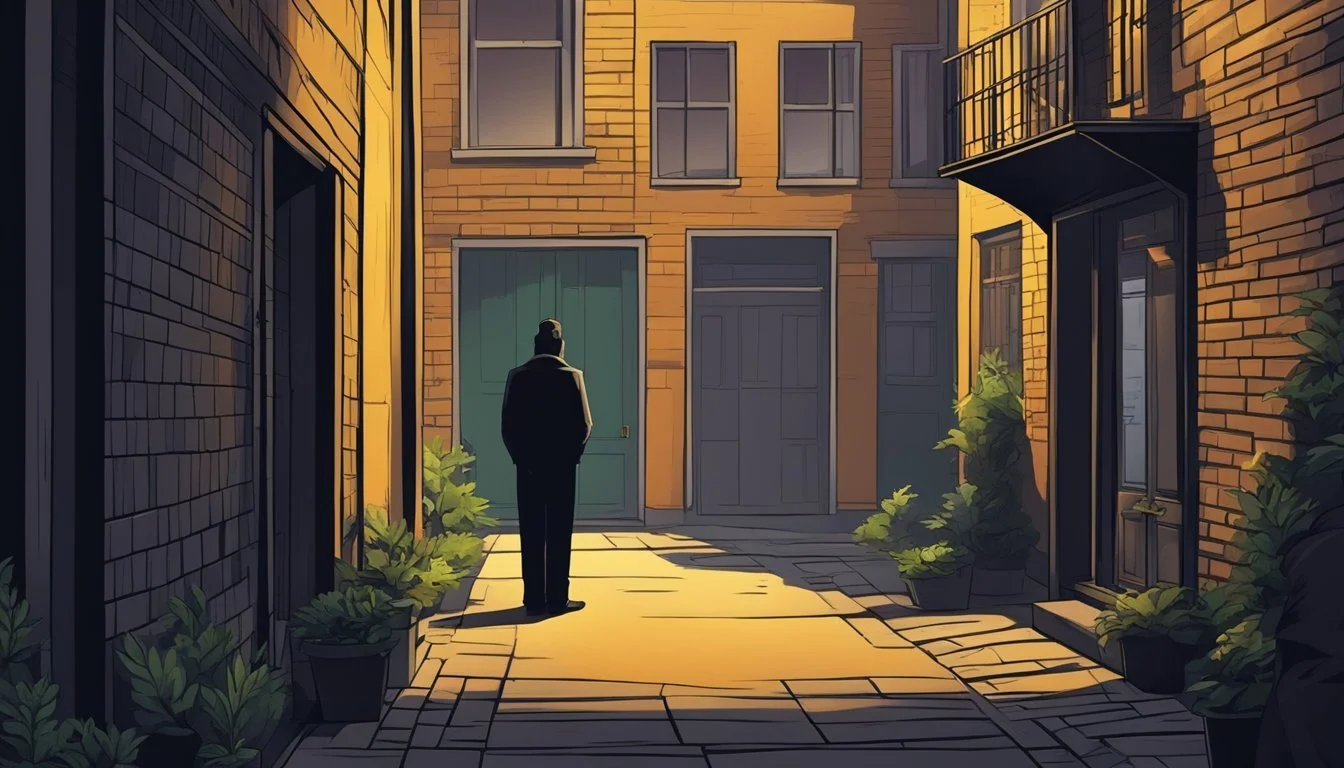Poughkeepsie's Dark Secret: Kendall Francois and the Missing Sex Workers
Serial Killer's Reign of Terror Exposed
In the late 1990s, the quiet town of Poughkeepsie, New York became the hunting ground for a serial killer. Kendall Francois, a school monitor by day, preyed on local sex workers, leaving a trail of disappearances that baffled authorities for years.
Between 1996 and 1998, Francois murdered eight women, all involved in prostitution, and concealed their bodies in his family home. His crimes went undetected for an extended period, despite growing concerns about missing persons in the area.
The case of Kendall Francois exposed the vulnerabilities of marginalized communities and the challenges law enforcement faces in connecting seemingly unrelated disappearances. It remains a chilling chapter in Poughkeepsie's history, serving as a stark reminder of the darkness that can lurk behind an ordinary facade.
Overview of Kendall Francois
Kendall Francois was a serial killer who terrorized Poughkeepsie, New York from 1996 to 1998. He targeted and murdered eight women, primarily sex workers, before his arrest.
Background and Early Life
Kendall Francois was born on July 26, 1971, in Poughkeepsie, New York. He grew up in a modest home with his parents and sister. As a young adult, Francois worked as a school monitor in the Arlington School District.
Despite his seemingly normal background, Francois harbored dark tendencies. His large physical stature, standing at 6'4" and weighing around 250 pounds, would later play a role in his crimes.
Francois maintained a facade of normalcy while secretly engaging in criminal activities. He frequented areas known for sex work, becoming a regular customer for some of the women he would later victimize.
Criminal Profile
Francois targeted vulnerable women, specifically sex workers in the Poughkeepsie area. His victims shared similar physical characteristics: slight builds, dark hair, and predominantly white.
He lured his victims to his family home, where he committed the murders. Francois' modus operandi involved strangulation, with one exception where he drowned a victim.
The killer stored the bodies of his victims in the attic and crawl spaces of his house. This gruesome practice continued undetected for two years, even though he lived with his parents and sister.
Francois' crimes baffled local law enforcement, who struggled to connect the disappearances. His arrest in 1998 shocked the community and revealed the extent of his heinous acts.
Poughkeepsie's History with Crime
Poughkeepsie has grappled with criminal activity throughout its history. The city has faced challenges ranging from unsolved cold cases to violent incidents along its main thoroughfare.
The Hudson Valley Cold Cases
Poughkeepsie and the surrounding Hudson Valley region have seen their share of unsolved mysteries. Several cold cases have perplexed local law enforcement for decades.
One notable case involves the 1985 disappearance of Sheila Shepherd, a 36-year-old woman last seen in Poughkeepsie. Despite extensive searches, her fate remains unknown.
Another longstanding mystery is the 1979 murder of Donna Mairs, whose body was found in a wooded area near the city. The case remains open, with investigators still seeking leads.
These unresolved cases have left lasting impacts on the community, prompting periodic reviews and public appeals for information.
Main Street Murders
Poughkeepsie's Main Street, once a bustling commercial center, has witnessed violent crimes over the years. In the 1990s, the area gained notoriety for drug-related incidents and prostitution.
A series of homicides in the late 1990s heightened concerns about safety in the downtown area. These crimes included:
The 1997 shooting of a local business owner
A fatal stabbing outside a Main Street bar in 1998
Multiple assaults linked to drug disputes
Local authorities responded by increasing police presence and implementing community outreach programs. These efforts aimed to revitalize the area and reduce criminal activity.
The Victims and Their Stories
Kendall Francois targeted sex workers in Poughkeepsie, leaving a trail of devastation in his wake. His actions deeply affected the local community and shed light on the vulnerabilities faced by those in the sex industry.
List of Identified Victims
Eight women fell victim to Francois between 1996 and 1998:
Wendy Meyers, 30
Gina Barone, 29
Catherine Marsh, 31
Kathleen Hurley, 47
Mary Healey Giaccone, 29
Sandra Jean French, 51
Audrey Pugliese, 34
Catina Newmaster, 25
These women shared similar physical characteristics: white, slight build, and dark hair. Francois initially targeted sex workers he had previously hired.
He picked up his first victim, Wendy Meyers, at the Valley Rest Motel on October 24, 1996. During their encounter, Francois strangled her.
Impact on the Sex Worker Community
Francois' crimes sent shockwaves through Poughkeepsie's sex worker community. The disappearances created an atmosphere of fear and distrust among those working in the industry.
Many sex workers became more cautious, implementing safety measures such as sharing client information with trusted friends. Some left the profession altogether, fearing for their lives.
The case highlighted the dangers faced by sex workers and the need for better protection and support systems. It also exposed gaps in law enforcement's approach to missing persons cases involving marginalized individuals.
Investigation and Evidence
The investigation into the Poughkeepsie missing persons cases spanned several years, revealing a series of challenges and breakthroughs. Key evidence ultimately led to the arrest of Kendall Francois in 1998.
Discovery of Remains
Law enforcement made a grim discovery in Francois' family home. Eight bodies were found hidden within the residence. The remains were located in various spaces, including the attic and basement.
Investigators faced difficulties due to the advanced decomposition of some victims. Forensic teams worked meticulously to identify each woman and determine their time of death.
The house on Fulton Avenue became a crucial crime scene. It provided a wealth of physical evidence linking Francois to the murders.
Role of Law Enforcement
Local police initially struggled to connect the disappearances. The victims' involvement in sex work complicated early investigations.
Task forces were formed to address the growing number of missing persons. Detectives interviewed known sex workers and their clients for leads.
Surveillance operations targeted areas frequented by sex workers. Undercover officers posed as potential clients to gather information.
DNA evidence played a critical role in the case. Samples collected from victims were compared to those from potential suspects.
Cold Case Investigations
Before Francois' arrest, several disappearances remained unsolved. Cold case units reviewed old evidence and witness statements.
New technologies allowed for reexamination of physical evidence. Advanced DNA testing techniques provided fresh insights into unsolved cases.
Investigators reached out to the public for additional information. Tip lines and reward programs were established to encourage new leads.
The resolution of these cold cases brought closure to many families. It also highlighted the importance of perseverance in long-term investigations.
Media Influence and Public Perception
The Kendall Francois case sparked intense media coverage and public fascination. Various forms of media, including films, books, and documentaries, have explored the dark events that unfolded in Poughkeepsie.
The Poughkeepsie Tapes Controversy
"The Poughkeepsie Tapes," a fictional horror film directed by John Erick Dowdle, drew inspiration from the Francois case. Released in 2007, it employed a found footage style to depict a serial killer in Poughkeepsie.
The film sparked controversy due to its graphic content and blurring of fact and fiction. Many viewers mistook it for a genuine documentary, leading to confusion about the real events.
Critics debated the ethics of using a real tragedy as the basis for a horror film. Some argued it exploited the victims' stories, while others saw it as a thought-provoking examination of violence and media sensationalism.
True Crime Literature and Documentaries
Several non-fiction works have examined the Francois case in detail. Claudia Rowe's book "The Spider and the Fly" provided an in-depth look at the killer and his victims.
Documentaries on streaming platforms have also covered the case. These productions often focus on the investigation process and the impact on the Poughkeepsie community.
True crime media has helped keep attention on unsolved aspects of the case, such as the disappearance of Michelle Eason. However, some critics argue that the genre can glorify killers at the expense of victims' stories.
The media coverage has influenced public perception of Poughkeepsie and raised awareness about violence against sex workers. It has also sparked discussions about law enforcement's handling of missing persons cases involving marginalized individuals.
Legal Proceedings and Aftermath
Kendall Francois faced justice for his heinous crimes in Poughkeepsie. The legal process brought closure to victims' families, while local institutions took steps to raise awareness about community safety.
Trial and Conviction
Francois was arrested on September 1, 1998, after a victim escaped and alerted authorities. He quickly confessed to murdering eight women. The trial began in 2000, with Francois pleading guilty to eight counts of first-degree murder.
On August 11, 2000, Francois was sentenced to life in prison without the possibility of parole. He avoided the death penalty due to his plea deal. The courtroom was filled with emotional testimonies from victims' families.
Francois showed little remorse during the proceedings. His lack of emotion struck many observers as particularly chilling.
Vassar College's Role in Community Awareness
Vassar College, located in Poughkeepsie, played a significant role in raising awareness about the case and its impact on the community. The college hosted forums and discussions about violence against sex workers and community safety.
Students and faculty organized vigils for the victims. These events helped humanize the women Francois targeted and highlighted the broader issues of violence against marginalized groups.
Vassar also implemented new safety measures on campus. These included increased security patrols and improved lighting in areas frequented by students.
Continuing Legacy and Impact
The Kendall Francois case exposed systemic issues in Poughkeepsie and sparked efforts to protect vulnerable populations. It led to changes in law enforcement practices and community outreach programs aimed at preventing similar tragedies.
Addressing Vulnerabilities of Marginalized Communities
Poughkeepsie implemented new policies to support sex workers and other at-risk groups. The police department established a dedicated unit to investigate missing persons cases, especially those involving marginalized individuals.
Community organizations partnered with local authorities to provide resources and safe spaces for sex workers. These initiatives included:
Free health clinics
Substance abuse treatment programs
Job training and education opportunities
The area around Hooker Avenue, once known for street prostitution, saw increased patrols and community revitalization efforts. This aimed to reduce crime and improve safety for residents and vulnerable individuals alike.
Educational Initiatives and Crime Prevention
Poughkeepsie schools incorporated personal safety and awareness programs into their curricula. These programs taught students about:
Recognizing potential dangers
Self-defense techniques
Reporting suspicious activities
Local colleges developed criminal justice courses that used the Francois case as a study in serial killer psychology and investigative techniques. This helped train future law enforcement professionals to better handle complex cases.
The Hudson River Valley became a focal point for regional crime prevention efforts. Annual conferences brought together experts to discuss strategies for protecting vulnerable populations and improving community safety.





